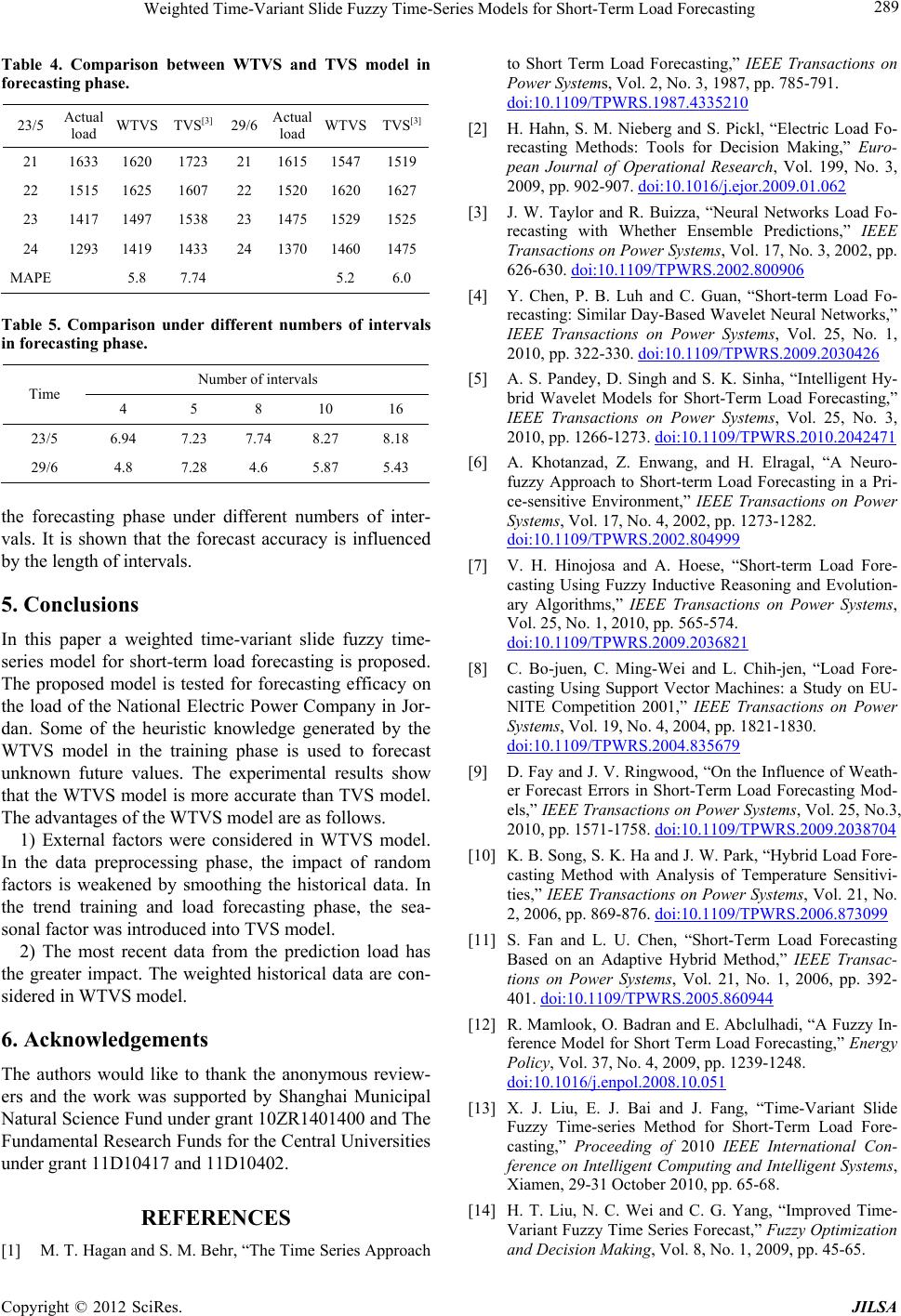
Weighted Time-Variant Slide Fuzzy Time-Series Models for Short-Term Load Forecasting 289
Table 4. Comparison between WTVS and TVS model in
forecasting phase.
23/5 Actual
load WTVS TVS[3] 29/6
Actual
load WTVS TVS[3]
21 1633 1620 1723 21 1615 15471519
22 1515 1625 1607 22 1520 16201627
23 1417 1497 1538 23 1475 15291525
24 1293 1419 1433 24 1370 14601475
MAPE 5.8 7.74 5.2 6.0
Table 5. Comparison under different numbers of intervals
in forecasting phase.
Number of intervals
Time
4 5 8 10 16
23/5 6.94 7.23 7.74 8.27 8.18
29/6 4.8 7.28 4.6 5.87 5.43
the forecasting phase under different numbers of inter-
vals. It is shown that the forecast accuracy is influenced
by the length of intervals.
5. Conclusions
In this paper a weighted time-variant slide fuzzy time-
series model for short-term load forecasting is proposed.
The proposed model is tested for forecasting efficacy on
the load of the National Electric Power Company in Jor-
dan. Some of the heuristic knowledge generated by the
WTVS model in the training phase is used to forecast
unknown future values. The experimental results show
that the WTVS model is more accurate than TVS model.
The advantages of the WTVS model are as follows.
1) External factors were considered in WTVS model.
In the data preprocessing phase, the impact of random
factors is weakened by smoothing the historical data. In
the trend training and load forecasting phase, the sea-
sonal factor was introduced into TVS model.
2) The most recent data from the prediction load has
the greater impact. The weighted historical data are con-
sidered in WTVS model.
6. Acknowledgements
The authors would like to thank the anonymous review-
ers and the work was supported by Shanghai Municipal
Natural Science Fund under grant 10ZR1401400 and The
Fundamental Research Funds for the Central Universities
under grant 11D10417 and 11D10402.
REFERENCES
[1] M. T. Hagan and S. M. Behr, “The Time Series Approach
to Short Term Load Forecasting,” IEEE Transactions on
Power Systems, Vol. 2, No. 3, 1987, pp. 785-791.
doi:10.1109/TPWRS.1987.4335210
[2] H. Hahn, S. M. Nieberg and S. Pickl, “Electric Load Fo-
recasting Methods: Tools for Decision Making,” Euro-
pean Journal of Operational Research, Vol. 199, No. 3,
2009, pp. 902-907. doi:10.1016/j.ejor.2009.01.062
[3] J. W. Taylor and R. Buizza, “Neural Networks Load Fo-
recasting with Whether Ensemble Predictions,” IEEE
Transactions on Power Systems, Vol. 17, No. 3, 2002, pp.
626-630. doi:10.1109/TPWRS.2002.800906
[4] Y. Chen, P. B. Luh and C. Guan, “Short-term Load Fo-
recasting: Similar Day-Based Wavelet Neural Networks,”
IEEE Transactions on Power Systems, Vol. 25, No. 1,
2010, pp. 322-330. doi:10.1109/TPWRS.2009.2030426
[5] A. S. Pandey, D. Singh and S. K. Sinha, “Intelligent Hy-
brid Wavelet Models for Short-Term Load Forecasting,”
IEEE Transactions on Power Systems, Vol. 25, No. 3,
2010, pp. 1266-1273. doi:10.1109/TPWRS.2010.2042471
[6] A. Khotanzad, Z. Enwang, and H. Elragal, “A Neuro-
fuzzy Approach to Short-term Load Forecasting in a Pri-
ce-sensitive Environment,” IEEE Transactions on Power
Systems, Vol. 17, No. 4, 2002, pp. 1273-1282.
doi:10.1109/TPWRS.2002.804999
[7] V. H. Hinojosa and A. Hoese, “Short-term Load Fore-
casting Using Fuzzy Inductive Reasoning and Evolution-
ary Algorithms,” IEEE Transactions on Power Systems,
Vol. 25, No. 1, 2010, pp. 565-574.
doi:10.1109/TPWRS.2009.2036821
[8] C. Bo-juen, C. Ming-Wei and L. Chih-jen, “Load Fore-
casting Using Support Vector Machines: a Study on EU-
NITE Competition 2001,” IEEE Transactions on Power
Systems, Vol. 19, No. 4, 2004, pp. 1821-1830.
doi:10.1109/TPWRS.2004.835679
[9] D. Fay and J. V. Ringwood, “On the Influence of Weath-
er Forecast Errors in Short-Term Load Forecasting Mod-
els,” IEEE Transactions on Power Systems, Vol. 25, No.3,
2010, pp. 1571-1758. doi:10.1109/TPWRS.2009.2038704
[10] K. B. Song, S. K. Ha and J. W. Park, “Hybrid Load Fore-
casting Method with Analysis of Temperature Sensitivi-
ties,” IEEE Transactions on Power Systems, Vol. 21, No.
2, 2006, pp. 869-876. doi:10.1109/TPWRS.2006.873099
[11] S. Fan and L. U. Chen, “Short-Term Load Forecasting
Based on an Adaptive Hybrid Method,” IEEE Transac-
tions on Power Systems, Vol. 21, No. 1, 2006, pp. 392-
401. doi:10.1109/TPWRS.2005.860944
[12] R. Mamlook, O. Badran and E. Abclulhadi, “A Fuzzy In-
ference Model for Short Term Load Forecasting,” Energy
Policy, Vol. 37, No. 4, 2009, pp. 1239-1248.
doi:10.1016/j.enpol.2008.10.051
[13] X. J. Liu, E. J. Bai and J. Fang, “Time-Variant Slide
Fuzzy Time-series Method for Short-Term Load Fore-
casting,” Proceeding of 2010 IEEE International Con-
ference on Intelligent Computing and Intelligent Systems,
Xiamen, 29-31 October 2010, pp. 65-68.
[14] H. T. Liu, N. C. Wei and C. G. Yang, “Improved Time-
Variant Fuzzy Time Series Forecast,” Fuzzy Optimization
and Decision Making, Vol. 8, No. 1, 2009, pp. 45-65.
Copyright © 2012 SciRes. JILSA